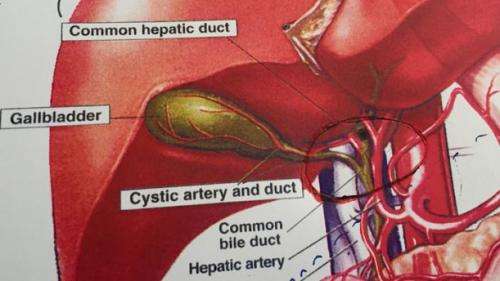Unique procedure offered for patients with inoperable bile duct cancers

University of Cincinnati Cancer Institute transplant surgeons are offering a unique procedure to remove inoperable, cancerous tumors from the bile duct of the liver, known as cholangiocarcinoma, potentially improving survival rates for patients who may otherwise have few treatment options.
"There is a high mortality rate for patients with this type of cancer, and only 40 percent of malignant tumors of the bile duct can be surgically removed," says Flavio Paterno, MD, assistant professor in the Division of Transplant Surgery at the UC College of Medicine, member of the UC Cancer Institute and UC Health transplant surgeon who performs the procedure. "It's such a small area in which to operate, leaving no room for error, and if we aren't able to remove the tumor in entirety, it could invade the arteries and lymph nodes. While chemotherapy and radiation therapy are options, like standard surgery, not all patients are eligible."
Paterno, who adds that UC Medical Center is the only facility regionally and only one of 12 facilities in the country offering this procedure, says the UC team developed a protocol based on one that was developed by the Mayo Clinic and others and is now offering comprehensive surgical and medical treatment for patients with resectable and unresectable bile duct cancer.
"Using this approved protocol, which involves patients who have been deemed eligible to also undergo radiation and chemotherapy, we remove the entire liver including the area of the bile duct where the tumor is located and disconnect the liver from the hepatic artery and portal vein," says Shimul Shah, MD, director of Liver Transplantation and Hepatobiliary Surgery and a member of the UC Cancer Institute. "Essentially, we are performing a liver transplant to remove the cancerous area and all surroundings of the bile duct."
He adds that this protocol has been shown to greatly increase survival rates for patients with inoperable bile duct cancer.
"This is an option that could completely cure the patient from his or her cancer and could eliminate what often happens to this subgroup of patients—diagnosis and then, soon, death," says Shah.
Paterno says that all patients are evaluated to see if standard procedures—a typical tumor removal via surgery—are a better fit. Patients who are not eligible for surgical removal will be enrolled in the new protocol in which they will undergo radiation and chemotherapy first, and then will be listed for liver transplant.
"We're excited to be offering this procedure for patients in the Tristate," he says, adding that they've involved medical and radiation oncologists and gastroenterologists into their treatment protocol and hope to involve a telemedicine component to it at some point for patients outside of the area. "Our multidisciplinary team will provide efficient, effective care for these patients who may not have been able to receive treatment otherwise."















